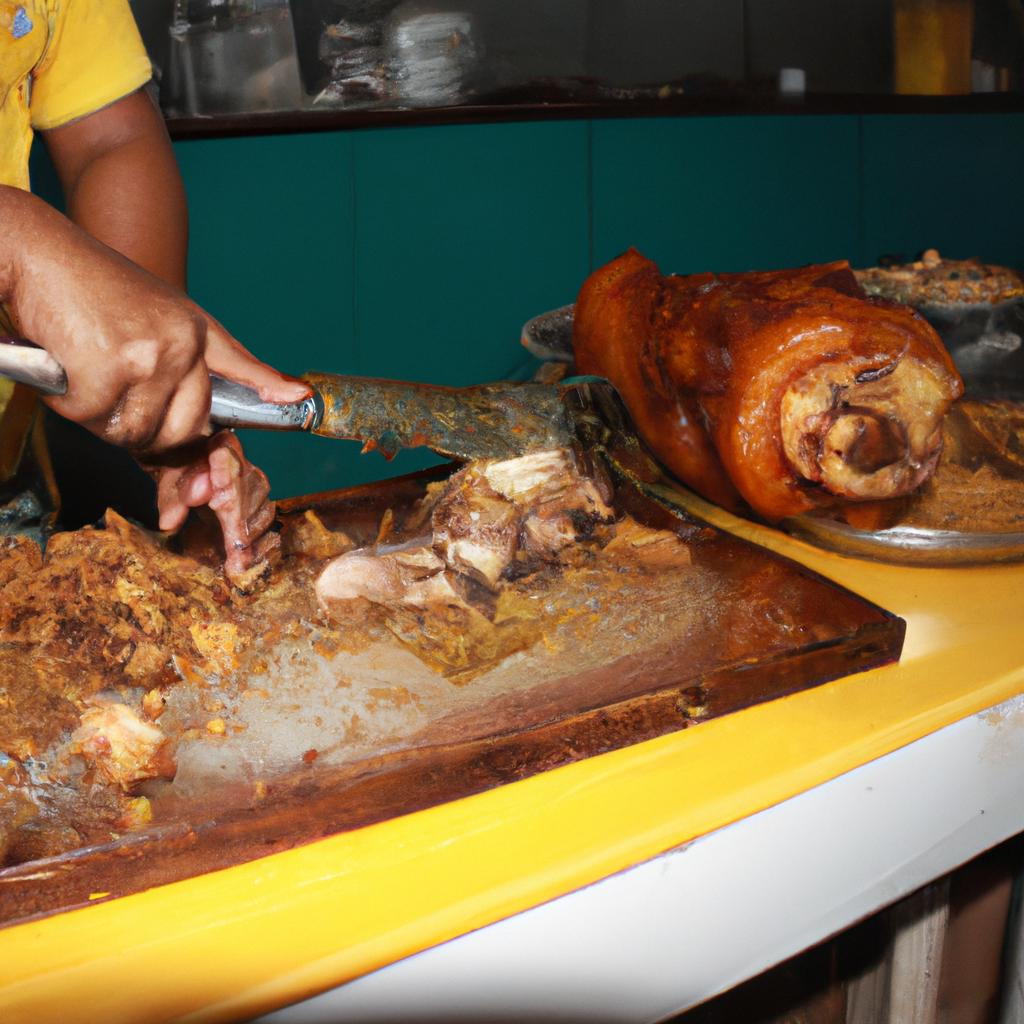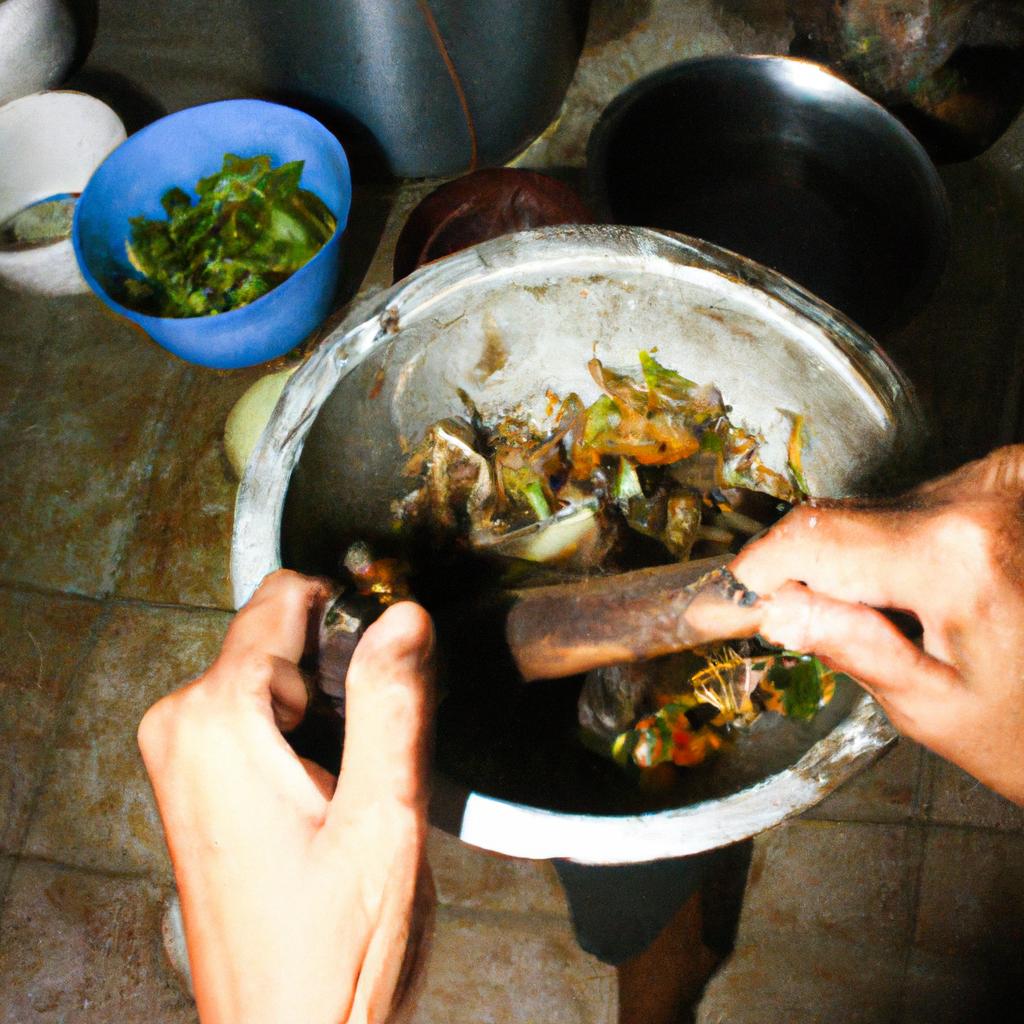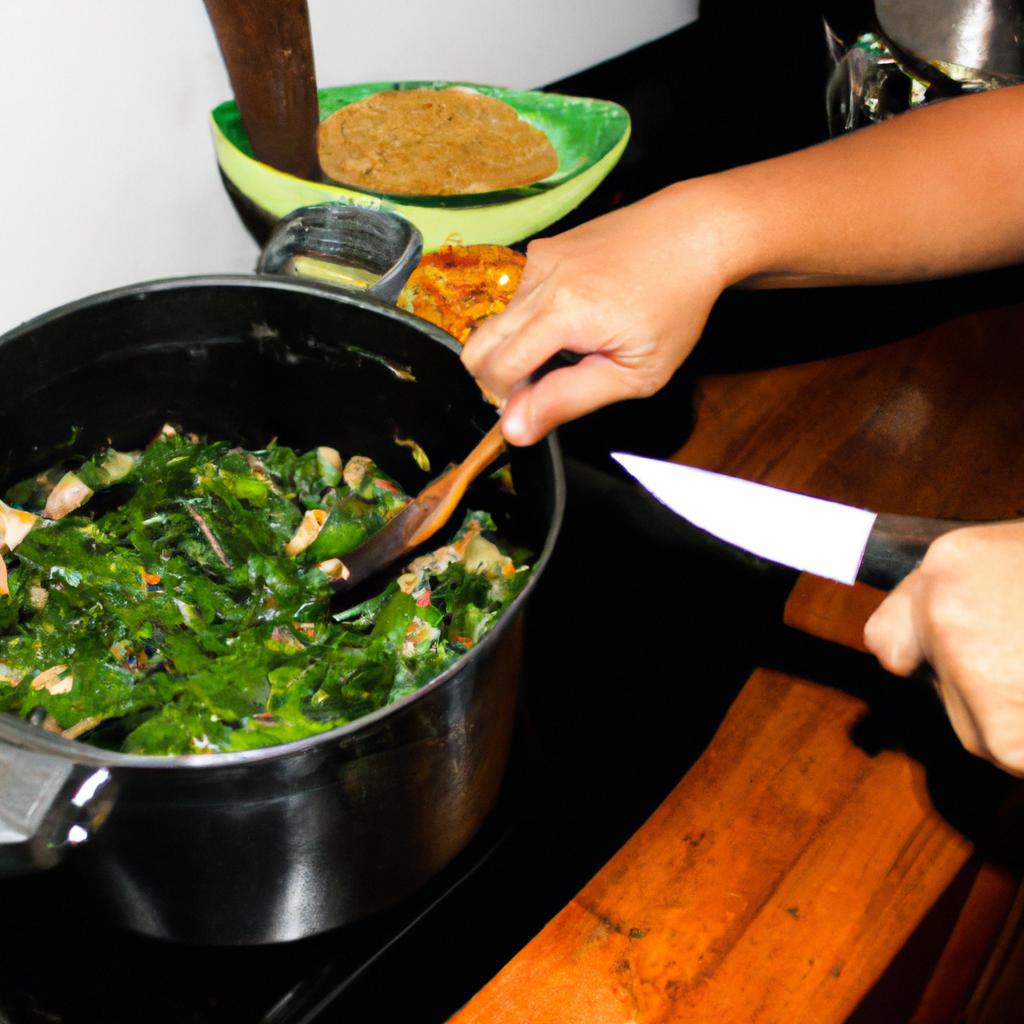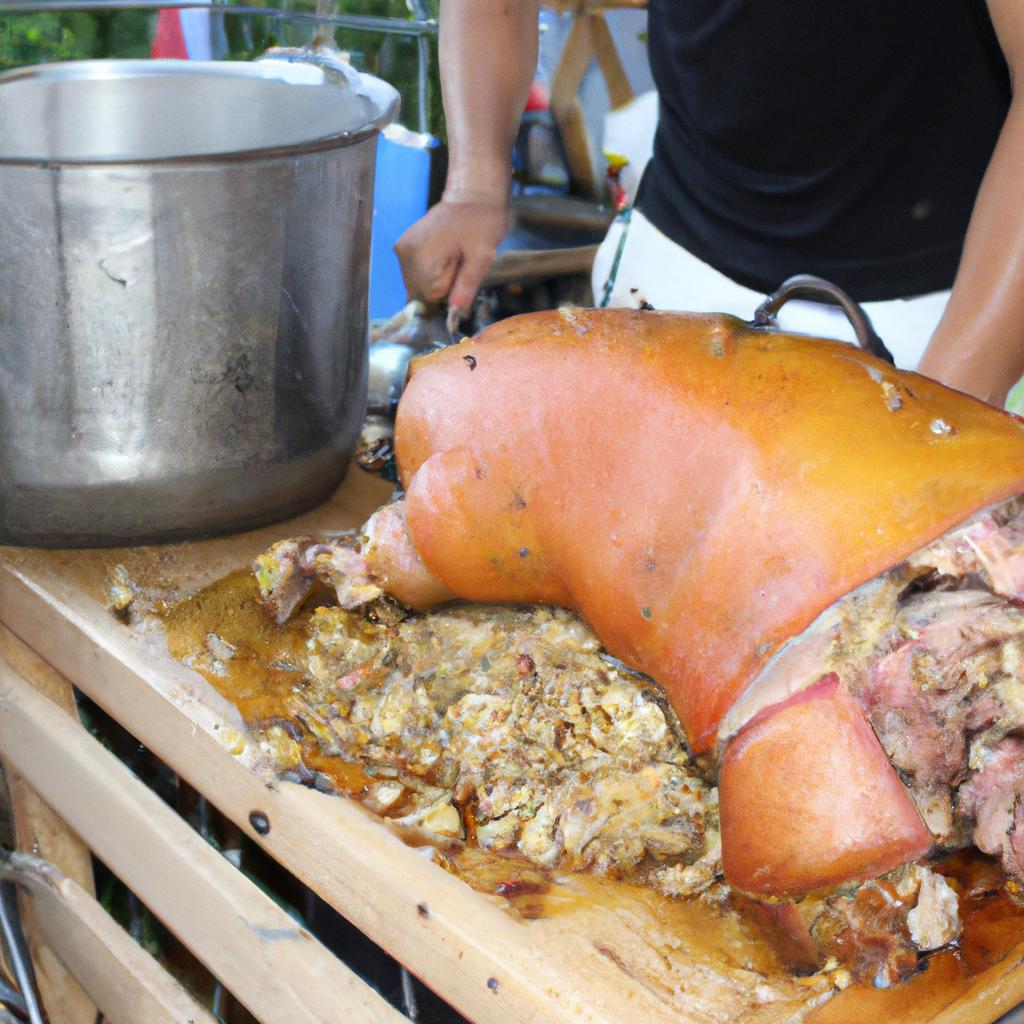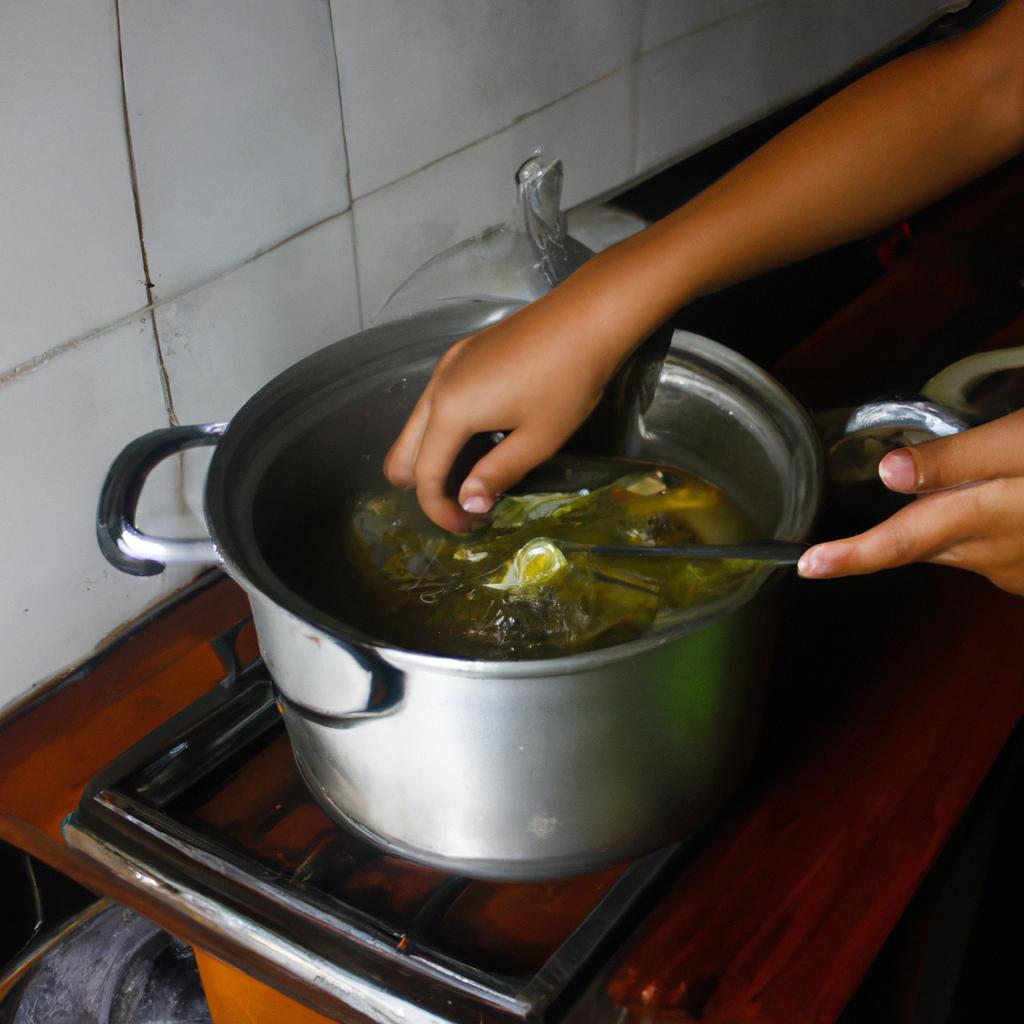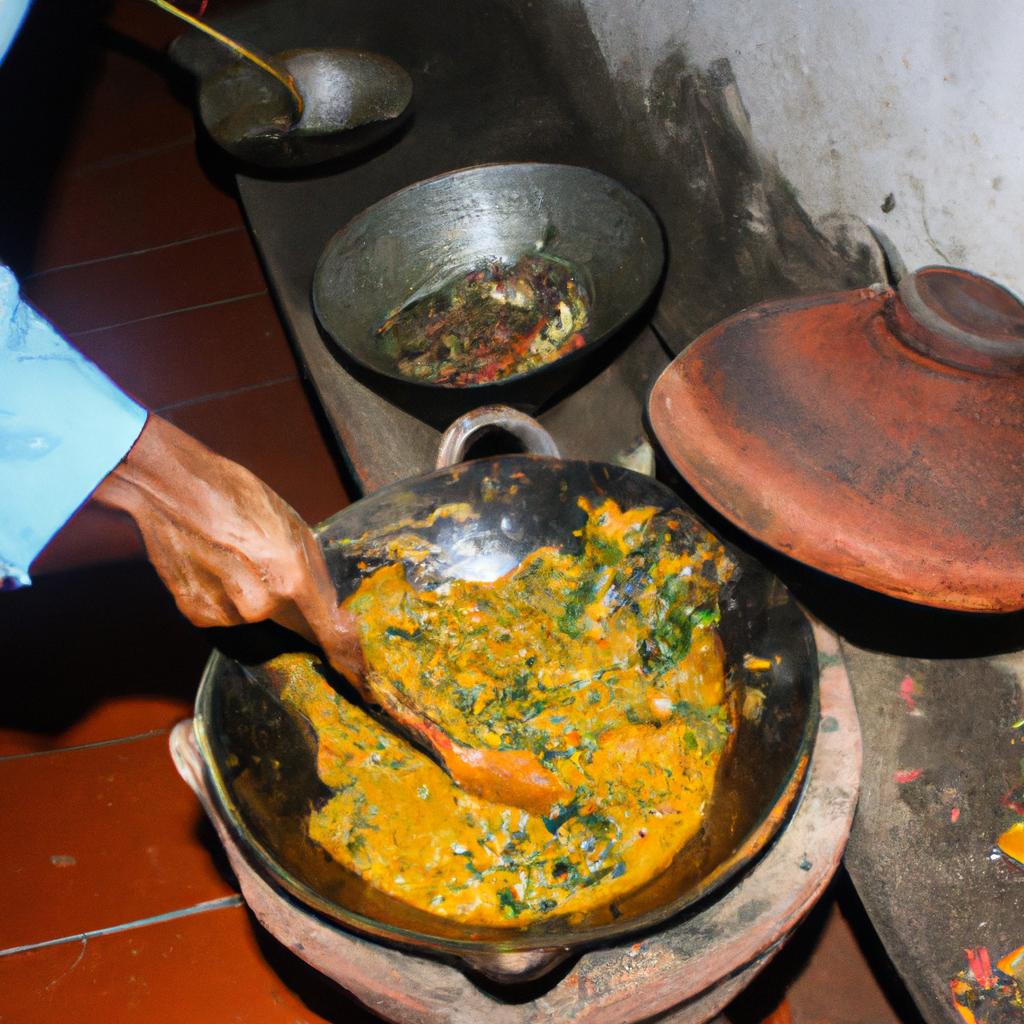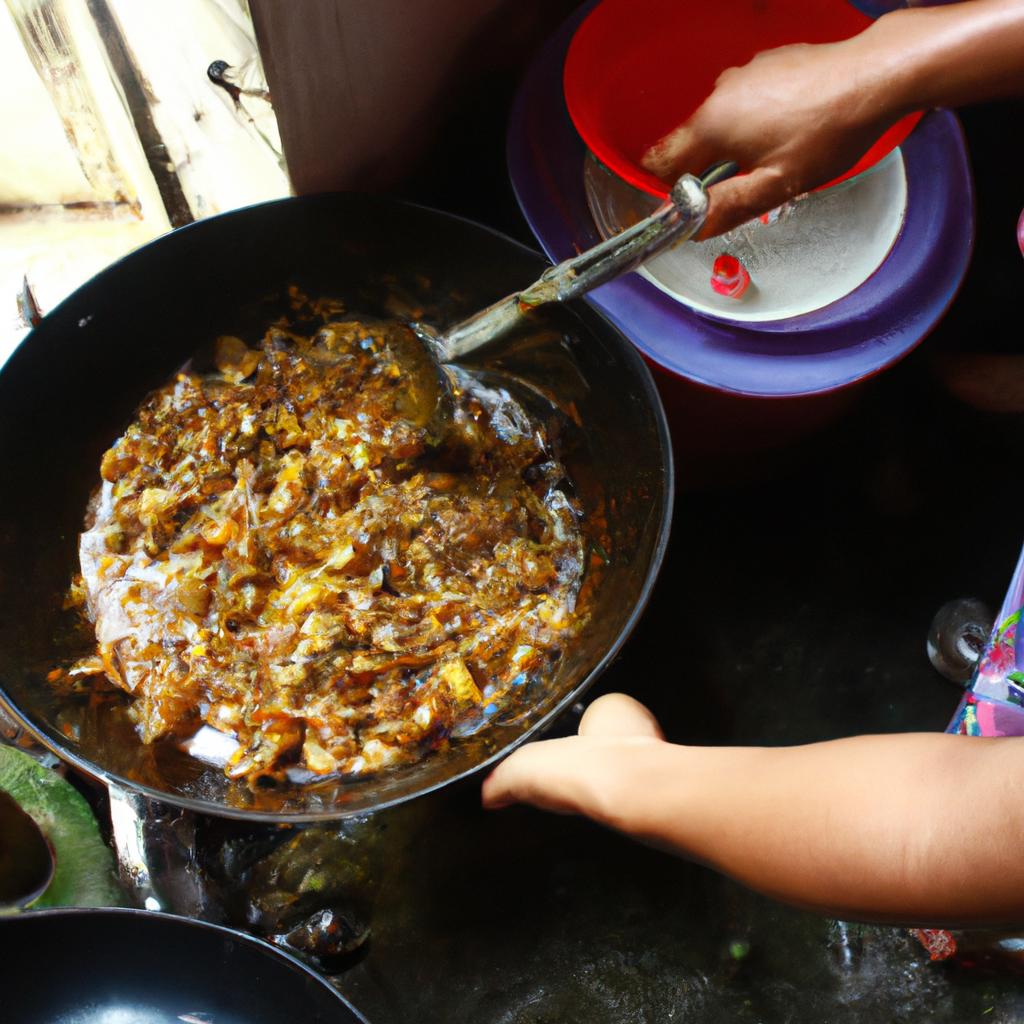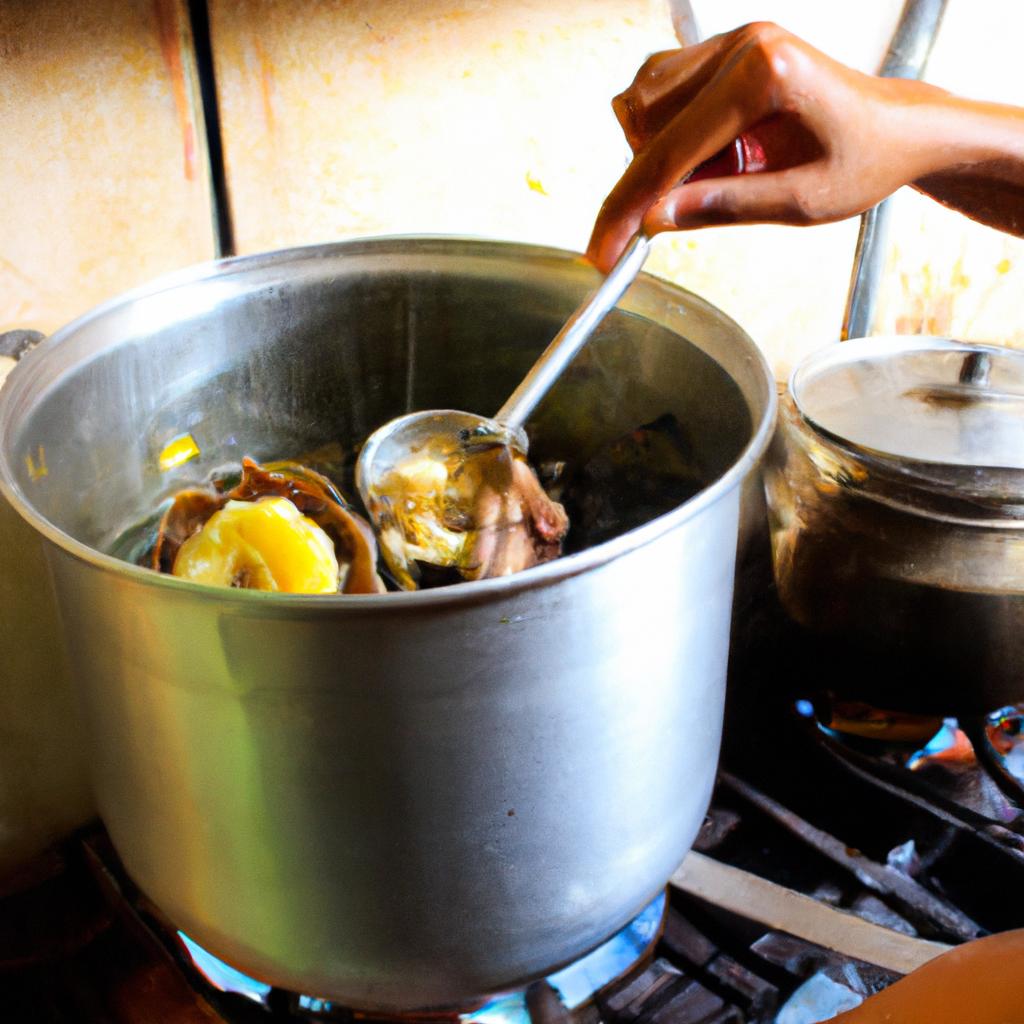In the realm of culinary delights, there are certain dishes that have become party staples, captivating taste buds and becoming synonymous with festive gatherings. One such delicacy is lechon, a traditional Filipino dish known for its succulent roasted pig served whole. The mere mention of lechon evokes images of grand celebrations and mouthwatering feasts, making it an indispensable centerpiece at weddings, birthdays, and other joyous occasions.
To illustrate the significance and popularity of lechon as a party staple, consider a hypothetical scenario where a group of friends decide to organize a birthday celebration for their friend Maria. As they brainstorm ideas for the menu, one suggestion consistently emerges: serving lechon as the main attraction. They unanimously agree that no other dish could match the splendor and gastronomic ecstasy that lechon promises. With this example in mind, it becomes evident that lechon has established itself as an integral part of Filipino culture and continues to captivate people’s palates around the world.
This article aims to shed light on the origins, preparation methods, regional variations, and cultural significance surrounding this beloved Filipino delicacy. By delving into these aspects, readers will gain a deeper understanding and appreciation for lechon’s role not only in Filipino cuisine but also in the hearts and memories of those who have experienced its delectable flavors.
Originating from Spain, lechon made its way to the Philippines during the colonial period. However, over time, it has evolved into a distinct Filipino dish, incorporating local ingredients and cooking techniques. The preparation process begins with selecting a young pig, typically weighing between 20 to 30 kilograms, which is then marinated overnight with various spices and seasonings. The most common marinade includes a mixture of soy sauce, garlic, onions, lemongrass, bay leaves, and black pepper. This marinade infuses the meat with rich flavors and acts as a tenderizer.
Once marinated, the pig is skewered on a large stick or bamboo pole before being roasted slowly over an open fire or in a specially designed oven called a “lechonan.” The roasting process takes several hours and requires constant attention to ensure even cooking and crispy skin. Skilled lechoneros (the term for those who specialize in roasting lechon) are highly sought after for their expertise in achieving the perfect balance of juicy meat and crispy skin.
The result is an awe-inspiring sight: a beautifully golden-brown pig with crackling skin that shatters upon contact. Breaking through this crisp exterior reveals succulent meat infused with smoky flavors from the slow-roasting process. Each bite is a harmonious blend of savory notes from the marinade melding with the natural sweetness of the pork.
While lechon is popular throughout the Philippines, regional variations add unique twists to this beloved dish. In Cebu City, for example, they take pride in their “Cebu Lechon,” known for its distinct flavor brought about by stuffing the pig’s belly cavity with aromatic herbs like tamarind leaves or lemon grass. Other regions may use different spices or methods of preparation that reflect their local culinary traditions.
Beyond its taste, lechon holds deep cultural significance in Filipino celebrations. It symbolizes abundance, prosperity, and the joy of coming together to share a meal with loved ones. In fact, no grand occasion is complete without a lechon at the center of the festivities. Its presence represents not only the generosity of the hosts but also their desire to create unforgettable experiences for their guests.
In conclusion, lechon has become an iconic dish in Filipino cuisine, captivating taste buds and playing a central role in joyful gatherings. Its origins from Spain have transformed into a uniquely Filipino delicacy that continues to evolve through regional variations and personal touches. Whether it’s a birthday celebration or a wedding feast, serving lechon promises an experience filled with mouthwatering flavors and cherished memories that will last a lifetime.
History of Lechon
Imagine attending a festive Filipino celebration, the air filled with laughter and music, tables adorned with an array of mouthwatering dishes. Among these culinary delights stands a magnificent centerpiece that captures everyone’s attention – the lechon. This traditional Filipino delicacy holds a special place in Filipino culture and has become a staple dish at celebrations, representing not only delicious flavors but also deep-rooted traditions.
Dating back centuries ago, lechon has its origins in Spain during the colonization period when Spanish colonizers introduced their cuisine to the Philippines. Over time, the Filipinos adopted and transformed the concept of roasting pork into their own unique style.
To fully appreciate the cultural significance of lechon, it is essential to understand its historical context:
- Symbolism: Lechon serves as a symbol of unity and generosity within Filipino communities. It often takes center stage at major events such as weddings, birthdays, and fiestas, where it becomes a focal point for sharing joy and celebrating important milestones.
- Craftsmanship: Preparing lechon requires intricate craftsmanship passed down through generations. Skilled artisans meticulously season the pig with various herbs and spices before slow-roasting it over open flames for several hours until achieving crispy skin while keeping the meat inside tender and succulent.
- Community Bonding: The process of preparing lechon often involves family members and friends coming together to help create this delectable masterpiece. This communal experience strengthens bonds among individuals who gather around to share stories, laughter, and skills in creating this culinary delight.
- Regional Variations: Each region in the Philippines boasts its version of lechon, adding diversity to this beloved dish across different provinces. From Cebu’s renowned “lechon Cebu” known for its distinct flavor profile to Negros’ “lechong baboy,” which features a sweet and tangy sauce, these regional variations contribute to the rich tapestry of Filipino cuisine.
Embraced by Filipinos both locally and abroad, lechon continues to captivate taste buds and evoke feelings of nostalgia. Its place as a centerpiece in celebrations highlights its cultural significance, representing unity, craftsmanship, community bonding, and regional diversity. In the following section, we will explore the ingredients and intricate preparation techniques that make lechon an extraordinary culinary experience.
Ingredients and Preparation
Section Title: The Cultural Significance of Lechon
To truly understand the cultural significance of lechon, let us consider a hypothetical scenario. Imagine attending a traditional Filipino celebration where the centerpiece is a whole roasted pig, glistening with crispy skin and succulent meat within. As you witness the anticipation on people’s faces and the communal excitement surrounding this iconic dish, it becomes evident that lechon holds a special place in Filipino culture.
This beloved delicacy has become an integral part of various festivities across the Philippines. Its presence signifies joyous occasions such as weddings, birthdays, fiestas, or even simple family gatherings. Beyond its delectable taste, lechon embodies more than just culinary excellence; it represents unity, abundance, and shared moments of happiness among loved ones.
The emotional connection Filipinos have with lechon can be attributed to several factors:
- Tradition: Passed down through generations, the art of roasting a whole pig has been ingrained in Philippine culture for centuries. Families take pride in their unique recipes and cooking techniques, ensuring that each occasion is accompanied by a distinct flavor profile.
- Symbolism: Being served lechon at an event symbolizes hospitality and generosity from the hosts towards their guests. It reflects how Filipinos embrace visitors warmly into their homes and communities.
- Celebration: The mere sight of a beautifully presented lechon creates an atmosphere of festivity. Sharing stories and laughter while enjoying this sumptuous feast brings people together in joyful camaraderie.
- Pride: Lechon serves as both a national treasure and a source of local pride for different regions throughout the country. Each area boasts its own regional variations, showcasing diverse flavors influenced by specific ingredients or cooking methods.
Embracing the cultural significance of lechon allows us to delve deeper into its preparation and regional variations. In the upcoming section, we will explore the various ingredients that contribute to this mouthwatering delicacy and uncover the traditional cooking techniques employed by Filipino households across different regions.
Regional Variations
Transitioning from the previous section on ingredients and preparation, let’s delve into the regional variations of this renowned Filipino delicacy. To illustrate the diverse flavors that lechon can possess, consider the hypothetical case study of two neighboring provinces in the Philippines – Cebu and Batangas.
In Cebu, lechon is prepared by marinating a whole pig with a combination of spices such as garlic, onion, bay leaves, and lemongrass. The pig is then skewered on a bamboo pole and cooked over an open fire for several hours until the skin turns crispy golden brown while keeping the meat inside tender and succulent. In contrast, Batangas-style lechon involves stuffing the pig with herbs like tamarind leaves and tanglad (lemongrass), adding another layer of flavor to each bite.
Exploring further regional variations across different parts of the country reveals intriguing differences in taste preferences:
- Visayas region: Known for its strong emphasis on seasoning, particularly using soy sauce-based marinades infused with various aromatic ingredients.
- Mindanao region: Showcasing influences from neighboring countries like Malaysia and Indonesia through their use of bold spices such as turmeric and ginger.
- Luzon region: Incorporates local ingredients like calamansi (Philippine lime) or even soda pop in their marinades to achieve a distinct sweet-savory balance.
These regional nuances make lechon not only a delightful culinary experience but also reflect the rich cultural diversity found within the Philippines.
| Region | Unique Flavor Profile | Notable Ingredient |
|---|---|---|
| Cebu | Balanced blend of herbs and spices | Lemongrass |
| Batangas | Pronounced herbal notes | Tamarind leaves, Tanglad (lemongrass) |
| Visayas | Savory with a soy sauce base | Aromatic ingredients |
| Mindanao | Bold and spicy with Malaysian-Indonesian influences | Turmeric, Ginger |
| Luzon | Sweet-savory balance with local twists | Calamansi, Soda pop |
These regional variations in lechon not only cater to diverse taste preferences but also serve as cultural markers that highlight the culinary heritage of each region. The popularity of lechon extends beyond being just a delectable dish; it embodies the collective identity and pride of Filipinos.
Transitioning into the subsequent section on “Cultural Significance,” we explore how lechon has become an integral part of Filipino celebrations and traditions.
Cultural Significance
Building upon the rich and diverse culinary heritage of the Philippines, regional variations of Lechon have emerged, each offering a unique twist to this beloved delicacy. Let’s explore some of these fascinating variations.
Paragraph 1:
One notable example is the Cebu-style Lechon, renowned for its distinct flavor and crispy skin. It is prepared by marinating the whole pig in a blend of spices such as lemongrass, garlic, and bay leaves before slowly roasting it over an open fire. The result is tender meat with crackling skin that has become synonymous with Cebuano cuisine.
Paragraph 2:
Aside from Cebu-style Lechon, other regions also boast their own versions. In Ilocos, they have what is called Bagnet Lechon—a fusion of two Filipino favorites—where pork belly is seasoned then deep-fried to achieve a delightful crunchiness on the outside while maintaining succulent meat inside. Moving further south to Batangas, they take pride in their Balayan-style Lechon which features a tangy marinade made from vinegar and calamansi juice, giving it a uniquely zesty taste.
Paragraph 3:
To provide you with a visual representation of the various regional variations of Lechon across the Philippines, here’s an evocative bullet point list and table showcasing four different styles:
- Cebu-style Lechon: Tender meat with irresistible crispy skin.
- Bagnet Lechon (Ilocos): Deep-fried pork belly boasting both crunchiness and juiciness.
- Balayan-style Lechon (Batangas): Zest-infused roast pig enhanced by tangy flavors.
- La Paz Batchoy-stuffed Lechon (Iloilo): A marriage between savory pork broth soup dish and roasted pig.
| Region | Style | Key Features |
|---|---|---|
| Cebu | Cebu-style Lechon | Tender meat, crispy skin |
| Ilocos | Bagnet Lechon | Crunchy pork belly with juicy interior |
| Batangas | Balayan-style Lechon | Zesty marinade, tangy flavors |
| Iloilo | La Paz Batchoy-stuffed Lechon | Combination of soup dish and roasted pig |
These regional variations not only showcase the diversity within Filipino cuisine but also highlight the cultural significance that lechon holds in various parts of the country. Now let’s delve deeper into its cultural importance and explore the popular occasions where this delectable delicacy takes center stage.
Note: The subsequent section about “Popular Occasions for Lechon” will be continued without explicitly mentioning a transition step at this point.
Popular Occasions for Lechon
Cultural Significance
Lechon, a Filipino delicacy renowned for its flavorful and crispy skin, holds great cultural significance in the Philippines. This section will explore the deep-rooted traditions associated with lechon and shed light on its importance in Filipino culture.
To better understand the cultural significance of lechon, let us consider a hypothetical scenario. Imagine a traditional Filipino fiesta where families gather to celebrate special occasions such as birthdays or weddings. In this festive setting, the centerpiece is often a whole roasted pig – the iconic lechon. The preparation and serving of lechon are steeped in age-old customs that reflect unity, generosity, and communal bonding.
The cultural value of lechon can be further appreciated through these key aspects:
- Symbolism: Lechon symbolizes abundance, prosperity, and good fortune. It signifies an occasion worth celebrating and showcases the host’s hospitality.
- Skillful Preparation: Roasting a whole pig requires expertise and meticulous attention to detail. The process involves marinating the pig with secret family recipes passed down through generations, skewering it over open flames, and slowly rotating it until perfectly cooked.
- Feast for All: Lechon serves as a feast for everyone attending an event. Its large size allows it to feed numerous guests, embodying inclusivity and ensuring that no one leaves hungry.
- Social Bonding: The act of sharing lechon brings people together in celebration. From gathering around the table to enjoying each bite together, it fosters connections among individuals within communities.
- Experiencing the mouth-watering aroma wafting from freshly roasted lechon
- Tasting the crackling sound as you bite into its crunchy skin
- Feeling a sense of belonging while engaging in lively conversations around the lechon table
- Witnessing the joy and gratitude expressed by guests when partaking in this traditional delicacy
Additionally, we can visualize these cultural elements using a table:
| Cultural Aspects | Lechon’s Influence |
|---|---|
| Abundance | Represents prosperity and good fortune |
| Expertise | Showcases culinary skills passed down through generations |
| Inclusivity | Feeds numerous guests, ensuring no one goes hungry |
| Social Bonding | Fosters connections among individuals within communities |
In conclusion, lechon holds deep-rooted cultural significance in Filipino society. Its symbolism, skillful preparation, role as a communal feast, and ability to foster social bonding make it an integral part of various celebrations. Moving forward to the next section about “Serving and Accompaniments,” let us explore how lechon is traditionally enjoyed alongside other delectable dishes.
Serving and Accompaniments
Section: The Art of Preparing Lechon
Lechon, a popular Filipino delicacy, is not just a dish but an art form in itself. Its preparation requires time, skill, and meticulous attention to detail. In this section, we delve into the intricate process of preparing lechon, exploring its various stages and highlighting the expertise involved.
Imagine a bustling kitchen filled with the aroma of roasting pork. The centerpiece of the occasion is a succulent whole pig slowly turning on a spit over an open fire. This classic scene exemplifies the essence of lechon preparation – a labor-intensive process that brings people together in celebration.
To create the perfect lechon, several steps must be followed meticulously:
- Selection: A high-quality pig is crucial for achieving excellent results. Farmers rear specific breeds known for their tenderness and flavor.
- Marination: Before cooking, the pig is marinated overnight or even longer to infuse it with flavors like garlic, lemongrass, and spices.
- Roasting: The most critical stage involves slow-roasting the pig on a specially designed spit. Skilled cooks monitor every aspect – adjusting heat levels and basting regularly – to ensure even cooking and achieve crispy skin.
- Presentation: Finally, when the meat has been cooked to perfection and achieved golden-brown crackling skin, it is ready to be presented as the centerpiece of any celebratory feast.
Let us now explore how serving lechon amplifies its appeal further through accompaniments such as sauces and side dishes.
| Sauce | Description | Pairing |
|---|---|---|
| Sarsa | A sweet liver-based sauce | Perfect for dipping |
| Lechon Sauce | Thick tomato-based sauce | Classic companion |
| Spicy Vinegar | Tangy vinegar infused with chili peppers | Adds a zesty kick |
| Mang Tomas | A savory liver sauce | Traditional choice |
This traditional Filipino delicacy, with its intricate preparation and vibrant accompaniments, continues to be the highlight of various festive occasions. The artistry involved in transforming a whole pig into a mouthwatering masterpiece truly sets lechon apart as an exceptional party staple.
As we conclude this section, it is evident that preparing lechon requires not only culinary expertise but also an understanding and respect for tradition. From selecting the perfect pig to slow-roasting it to perfection, each step contributes to creating an unforgettable experience for those fortunate enough to savor this beloved delicacy. So next time you find yourself at a celebration where lechon takes center stage, take a moment to appreciate the craftsmanship behind this delectable dish.

